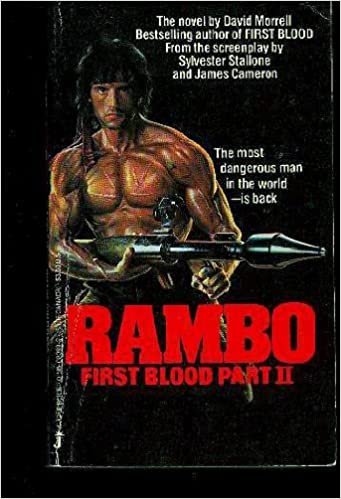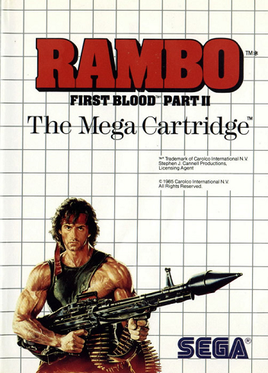Our Tribute to Kennedy Center Honors Recipients Continues With This Rerun of 1985's Iconic Rambo: First Blood Part II
Welcome, friends, to the latest entry in Control Nathan Rabin 4.0. It’s the career and site-sustaining column that gives YOU, the kindly, Christ-like, unbelievably sexy Nathan Rabin’s Happy Place patron, an opportunity to choose a movie that I must watch, and then write about, in exchange for a one-time, one hundred dollar pledge to the site’s Patreon account. The price goes down to seventy-five dollars for all subsequent choices.
When people think about the character of John Rambo, they almost invariably do not think about the macho icon in his original or authentic version.
Though the character will forever be associated with Sylvester Stallone, he was created by novelist David Morrell for the 1972 novel First Blood.
Morrell’s novel depicted John Rambo as a broken, deeply troubled, PTSD-ravaged loner whose experiences in Vietnam rendered him unable to function in civilian society.
The shaggy drifter just wants to be left alone with his almost inconceivable pain, but when a group of sadistic small-town lawmen begin antagonizing the living personification of the boundless trauma of the Vietnam War, he snaps.
Ted Kotcheff’s 1982 film adaptation of Morrell’s novel followed suit. It was a dark, uncompromising character study of a violent man betrayed by the cultural forces sworn to protect him.
That, needless to say, is NOT the Rambo of the public imagination. When we think of Rambo, we generally do not think of a suicidally depressed vagabond with a brain full of ghosts and demons.
Instead, we think of an uncomplicated American hero with an impossibly ripped physique massacring the enemies of freedom with machine guns, rocket launchers, bows, and big-ass knives.
This patriotic cartoon is NOT the Rambo of Morrell’s novel and Kotcheff’s adaptation but rather a cynical, opportunistic bastardization.
It’s not unlike how, when we think of Tony Manero, the iconic disco dancer John Travolta played in 1977’s Saturday Night Fever and 1983’s Staying Alive, we don’t think of the way the character was handled in the zeitgeist-capturing original film.
We don’t think of Tony Manero as a deeply depressed, profane, racist, and sexist monster who treats people, particularly women, besotted with him and his smooth moves, with heartbreaking cruelty and callousness.
Yet that’s exactly who Tony Manero is in Saturday Night Fever. When we think of Tony Manero, we instead see him as a clean-cut, drug-free, ambitious young man on the go who wants to make it in the high stakes world of dance and will do anything to achieve his goals and his little slice of the American Dream.
That’s the Tony Manero of Staying Alive, which re-imagined one of New Hollywood’s most fascinating bad guys as a tedious Reagan-era go-getter who had licked all his vices and now just wanted to make it.
Perhaps not coincidentally, Sylvester Stallone was behind this radical re-imagining of Tony Manero as a boring, one-dimensional hero.
The man who gave the world Rocky did not seem interested in darkness and moral ambiguity, only giving an adoring public clear-cut heroes to root for.
Rambo: First Blood: Part II opens with its title character relaxing in a prison camp due to all of the mischief and shenanigans he got up to in the first film.
Rambo, alas, is just too goddamned good at killing people to be left alone by the ghouls in the military. Rambo’s mentor/father figure, Colonel Sam Trautman (Richard Crenna), offers him an opportunity to escape his confinement and possibly score a presidential pardon if he successfully executes a mission that would be impossible for anyone but Rambo.
In Thailand, our hero learns more from duplicitous weasel Major Marshall Roger T. Murdock (Charles Napier). A small number of Prisoners of War remain in Vietnam, so the government wants Rambo to travel to Vietnam to confirm whether or not there are still captured soldiers behind enemy lines.
The duplicitous fuck-nuts at the Pentagon do not want Rambo to travel to Vietnam to free the hostages. They merely want him to take pictures.
Rambo: First Blood Part II depicts its hero as the greatest soldier in the history of the universe. And the Powers that Be try to turn him into a photojournalist. They want him to head to the place where many of his nightmares originated with a Polaroid camera so he can document the existence of American POWs behind enemy lines. They don’t want him to wreak righteous justice; they want sassy snaps, elegantly composed compositions filmed in just the right light.
They might as well tell Rambo to put his life in danger countless times so that he can write a report on POWs, then have that report notarized and sent to professional colleagues.
This is an early indication that the military brass cannot be trusted. Rambo: First Blood Part II portrays the military establishment as cowardly and unjust, a corrupt aggregation of self-interested opportunists who care about nothing beyond their own comfort and success. It similarly portrays the American people as a group that viciously turned their backs on Vietnam veterans when they needed them most.
The first two films of the franchise portray law enforcement, capitalism, the military, and the American people as malevolent forces that torment and betray American heroes, such as Rambo. Yet Rambo: First Blood Part II somehow manages to be flag-waving, jingoistic, and emptily patriotic all the same.
It’s a movie that waves the flag proudly while acknowledging that the actual USA is a cesspool that stabs its heroes in the back and leaves them for dead.
Rambo pretends to go along with the plan but I did not spot a single goddamn camera in the entire fucking film. How the hell is the man going to photograph desperate, dying POWs in desperate need of help if he doesn’t have a Polaroid or a Nikon to shoot pics with?
Stallone spends a fair amount of Rambo: First Blood Part II with his arms in a crucifixion pose as he nobly withstands brutal torture from the Vietnamese and their pals in Communism and evil, the Russians.
That makes sense, since in this live-action comic book Rambo is essentially a Sexy Murder Jesus who is ready, willing and able to sacrifice himself for the sake and his perfect body for the sake of an American military that is unworthy of him.
Rambo has the body of a Chippendale dancer. The movie exists in part to showcase, as exhaustively and extensively as possible, Stallone’s impossibly chiseled physique. Stallone is not a tall man, but he’s so impossibly muscular that his body seems almost impossible, like something that can exist in the world of sexual fantasy but not in real life.
Rambo is sexy yet asexual, as evidenced by his chaste bond with a Vietnamese woman who is the only non-white character depicted as anything other than evil. He’s Christ-like in his willingness to sacrifice his life for a country that never stops letting him down.
AND he’s REALLY good at killing people! World-class, even! He’s so good at killing people that it is literally unbelievable.
I’ve now seen Rambo: First Blood Part II three times or so but it feels like I’ve watched it at least a dozen times because pretty much every element of it has been parodied and ripped off so extensively.
That’s crazy, considering that the film is already so ridiculously over-the-top. Rambo: First Blood Part II is seemingly beyond parody, yet that hasn’t kept it from being spoofed extensively.
Story-wise, Rambo: First Blood Part II is like Apocalypse Now, only instead of the protagonist going upriver and facing his own heart of darkness, Rambo goes on a dazzlingly successful killing tour of North Vietnam before reaching a camp where POWs are being held in deplorable conditions.
Rambo: First Blood Part II was shot by Jack Cardiff, the Academy Award-winning genius DP behind Powell and Pressburger masterpieces like The Red Shoes, Black Narcissus, and A Matter of Life and Death, who was seventy at the time but inexplicably up for what I imagine was a physically exhausting gig.
Not surprisingly, Rambo: First Blood Part II looks fantastic, like the comic book version of Apocalypse Now, it suggests thematically as well. Cardiff gives the film a tactile quality; the film stock itself seems to sweat in the unrelenting heat of Vietnam.
The film is full of iconic moments that leap deliriously past brazen self-parody into a hyper-macho homoerotic patriotism porn.
In that respect, it resembles 1986’s Cobra, Stallone and director George P. Cosmatos’ subsequent collaboration, and a film that is spectacularly entertaining and re-watchable precisely because it is such a surreal Conservative fantasy of all-American badassery, not despite it.
Rambo: First Blood Part II sells the big lie that we could have won Vietnam, dammit, if we’d only left the war to unstoppable killing machines like Rambo instead of sniveling bureaucrats who just cared about their precious pensions and bonuses and vacation time, not the fight of our wounded warriors.
Rambo is fighting a war on two fronts here. He’s battling the Vietnamese and Russians, but he’s also battling the duplicity and corruption of his American superiors, most notably in the form of Napier’s wonderfully weaselly Murdock.
I love that in the background of many of Napier’s scenes, a glowing red Coca-Cola machine lingers conspicuously. Typically, it would be beneficial to have your product featured in a movie that grosses $ 300 million at the box office. But do you want your product to be associated with the evil bureaucrat who sends Rambo to die and then is mortified when he comes back alive and hungry for revenge?
USA! USA! USA!
Sorry about that, the movie was getting under my skin a little. Rambo doesn’t just basically defeat all of North Vietnam; he does so easily. Rambo versus North Vietnam isn’t a fair fight. The poor Vietnamese never stood a chance.
They’re all 5’2, 120 pounds and sweating profusely through ill-fitting uniforms while smoking cigarettes; he’s a superhuman super-soldier who says little but grunts angrily often.
Stallone acted in First Blood. He just poses and swaggers here. The movie exists to serve his enormous ego but in doing so it plugged directly into the power fantasy of men all over the world.
Rambo: First Blood Part II is spectacular pulp as long as you can overlook the fact that it’s also pretty fucking evil.
Pre-order The Fractured Mirror, the Happy Place’s next book, a 600 page magnum opus about American films about American films, illustrated by the great Felipe Sobreiro over at https://the-fractured-mirror.backerkit.com/hosted_preorders
The Joy of Trash, the Happy Place’s first non-"Weird Al” Yankovic-themed book is out! And it’s only 16.50, shipping, handling and taxes included, 30 bucks for two books, domestic only!
Buy The Joy of Trash, The Weird Accordion to Al and the The Weird Accordion to Al in both paperback and hardcover and The Weird A-Coloring to Al and The Weird A-Coloring to Al: Colored-In Special Edition signed from me personally (recommended) over at https://www.nathanrabin.com/shop
Or you can buy The Joy of Trash here and The Weird A-Coloring to Al here and The Weird Accordion to Al here
Help ensure a future for the Happy Place during an uncertain era AND get sweet merch by pledging to the site’s Patreon account at https://www.patreon.com/nathanrabinshappyplace We just added a bunch of new tiers and merchandise AND a second daily blog just for patrons!
Alternately you can buy The Weird Accordion to Al, signed, for just 19.50, tax and shipping included, at the https://www.nathanrabin.com/shop or for more, unsigned, from Amazon here.
I make my living exclusively through book sales and Patreon so please support independent media and one man’s dream and kick in a shekel or two!














